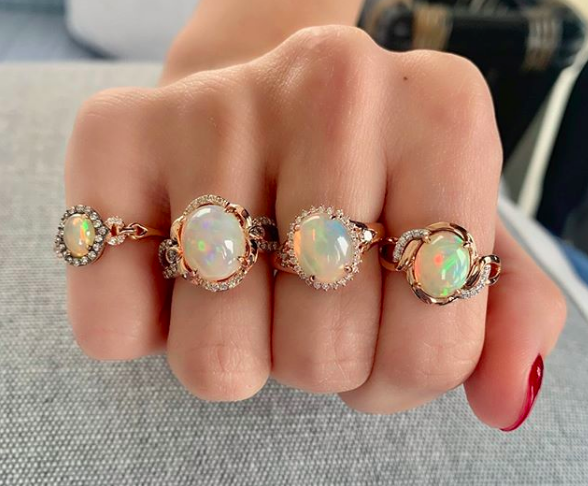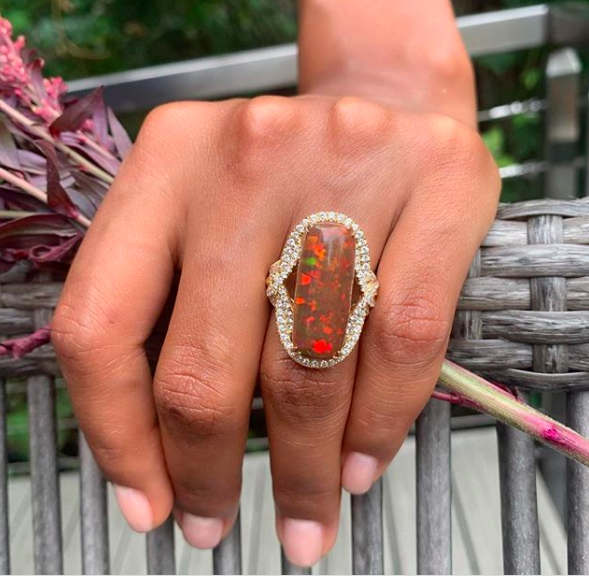Le Vian Neopolitan Opal™ and Beyond: Opal of the Future
Welcome to the Colorful World of Opals
One of the most unique and astounding elements in the world of jewels, and the October birthstone, is the opal. Treasured as both an accent gem and a centerpiece in its own right, the history of the opal is rich and storied. At the turn of the first century, Roman scholar Pliny the Elder observed that opals carry some of the richest colors of an artist’s palette; often with a light blue or green base, some have the flaming fire of burning sulfur while others resemble a kaleidoscope of precious stones such as ruby, emerald, topaz, sapphire and amethyst. Opal was and remains considered the most magical of all gems because it displays so many colors simultaneously, resulting in a rainbow-like effect.

Opal History
The term opal is thought to have come from the name of Ops, the Roman goddess of fertility, who was the wife of Saturn. During Saturnalia celebrations, which would today coincide with the Christmas holiday, the beautiful Ops was honored and revered; it is from this joyous spirit that the light-reflecting opal’s namesake was likely derived. And today, opal is the gemstone for faithful lovers, and for the astrological sign Libra. (In the star sign universe, Libras are known to be peaceful, fair, and very social. An opal happens to make a perfect pair with this personality type!)
Ancient Arabic legend says that opal falls from the heavens with flashes of lightning. In centuries past, Europeans considered the gem to be a symbol of hope, purity and truth. Today, it is used to mark the 14th wedding anniversary in many countries. British jewel expert and journalist Victoria Finlay said of the glistening gem, “In precious opals there might be a dash of red here, a seductive swirl of blue there, and in the center, a flirtatious glance of green. But each stone flickers with a unique fire and a good opal is one with an opinion of its own.”
Light interference plays a huge role in how an opal is perceived. The arrangement of hydrated silica spheres within an opal can vary by size and pattern, and together form the intricate display seen in an opal. Each opal has a different version of this interplay, meaning that no two look the same, and the range of color combinations and surface effect is just about endless.

Otherwordly Opals: A Mars Find Worth Pondering
One might even describe opal as “otherworldly”; in 2015, NASA reported that traces similar to what makes up opals were found on the surface of Mars. On Earth, opal is created from running ground water picking up silica and leaving the compound behind in cracks and voids in the landscape. As the water evaporates over millions of years, the eye-catching gem emerges. NASA’s revelation indicates that there may be flowing water on the surface of Mars—perhaps a Mars opal will be next most coveted specimen here on Earth!

Updates in the Opal Word: The Hydrophane Ethiopian Opal
The newest opal on the gem scene goes by the name of Hydrophane Ethiopian opal. These opals are more translucent than the more common Australian opal. “Hydrophane” (“water loving”) refers to their tendency to absorb water. Ethiopian opal has gained recent notoriety in the feature film Uncut Gems featuring Hollywood A-lister Adam Sandler and NBA star Kevin Garnett.
An advantage of Ethiopian opal, aside from its stunning presence, is its durability; this variety is less inclined to "craze" that some other varieties of opal; crazing is the development of internal cracks, which, much like a crack in a car windshield, can grow over time. Ethiopian opal also comes in a larger range of qualities and sizes than other opal types, making it a great option for either a wearable everday piece or an extra-special occasion piece for making a statement.
Le Vian Neopolitan Opal™
Another fascinating opal option is the Le Vian Neopolitan Opal™. The ancient Romans deemed this the most powerful of gems, while the Greeks attributed predictive powers to the gem. Later, in the West, this opal became a symbol of hope, purity and truth. In the public arena, Michelle Obama has been seen wearing a striking Le Vian Neopolitan Opal™ piece. Usable for earrings, necklaces, bracelets, and rings, this gem can show many faces with ease.
The Neopolitan Opal™ comes from only one mine in the world – the new Yahwah mine in Ethiopia – and features an intriguing play of background colors combined with a captivating iridescence. This modern-yet-classic gemstone blends seamlessly in a number of Le Vian® flavors of gold and diamonds, especially Strawberry Gold® and Chocolate Diamonds®.
How to Care for Your Opal Jewelry
Opals are as versatile as they are vivid; there are many types, including black (here is one incredible piece), white, fire, boulder, and water opals. They are often delicate, and if not artificially enhanced or treated, like Le Vian’s, is it is not advised to immerse your opal jewelry in liquids or expose them to harsh elements. For a piece that will always look new and fresh, with standout colors, interesting pattern and an unmistakable presence, opal is a clear winner!
Take a look at the what happens with various opals after being exposed to room-temperature water overnight!:

